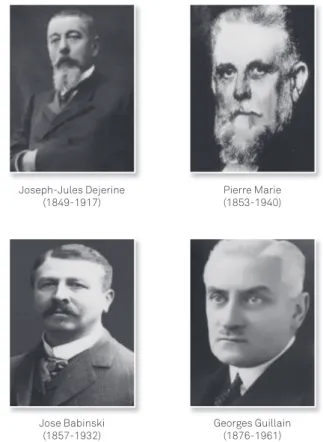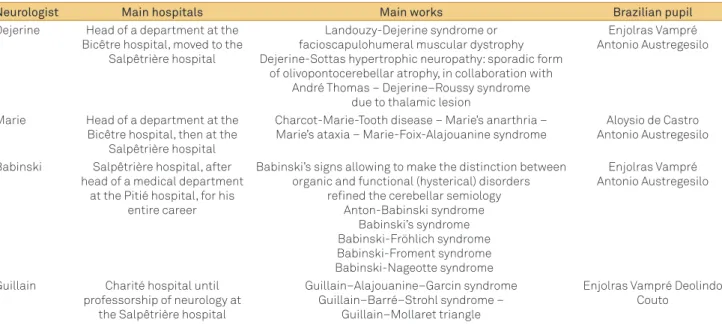818
HISTORICAL NOTE
DOI: 10.1590/0004-282X20130129
French school of neurology in the 19
th
and first half of the 20
th
century, and its
influence in Brazil
Escola francesa de neurologia no século 19 e primeira metade do
século 20, e sua influência no Brasil
Marleide da Mota Gomes1, José Luiz de Sá Cavalcanti2, Eliasz Engelhardt3
Brazilian medicine, in the 19th century and the irst half of 20th century was mainly inluenced by French medici ne, and
reinforced later by a German contribution2. his also includes
the inluence exerted by Jean-Martin Charcot (1825–1893) and his followers on the leaders of the irst Brazilian schools of neurology (in Rio de Janeiro, the majority, and also in São Paulo).
FRENCH MEDICINE: 19th CENTURY AND BEGINNING
OF THE 20th CENTURY
France after the Napoleonic revolution emphasized the hospital ward as the most important place for medical ac-tivity, and public health measures were seen as a duty of the State, with medical practice open to all classes3.
1Institute of Neurology Deolindo Couto, School of Medicine, Federal University of Rio de Janeiro (UFRJ), Rio de Janeiro RJ, Brazil; 2Institute of Neurology Deolindo Couto, UFRJ, Rio de Janeiro RJ, Brazil;
3Cognitive and Behavioral Neurology Unit, Institute of Neurology/Institute of Psychiatry, UFRJ, Rio de Janeiro RJ, Brazil.
Correspondence: Marleide da Mota Gomes; Instituto de Neurologia Deolindo Couto, UFRJ; Av. Venceslau Braz 95; 22290-140 Rio de Janeiro RJ - Brasil; E-mail: mmotagomes@acd.ufrj.br
Conflict of interest: There is no conflict of interest to declare.
Received 13 December 2012; Received in final form 09 May 2013; Accepted 16 May 2013. ABSTRACT
French medicine was of the utmost importance for the birth of modern medicine and neurology in the 19th century. Innovative approaches,
such as examination at the bedside, the use of the stethoscope, techniques of auscultation, palpation, and close patient examination, be-sides emphasis on anatomical-clinical correlation and observation of the outcome of the disease, were put into practice. French medicine offered professional training and incentives for the beginnings of Brazilian neurology and psychiatry. Returning from France, many Brazilian physicians implemented what they had learned, mainly in Paris. The most important pupils of the French neurology schools in Brazil during the 19th century and first half of the 20th century include names like Antonio Austregesilo, Aloysio de Castro, Enjolras Vampré, and Deolindo
Couto, founders of the leading Brazilian neurological schools, directly influenced by Dejerine, Pierre Marie, Guillain and Babinski.
Keywords: history, neurology, French school, Brazilian school.
RESUMO
A medicina francesa é de extrema importância para o nascimento da medicina moderna e a neurologia do século 19. Foram colocadas em prática diversas inovações, como exame à beira do leito, uso de estetoscópio, técnicas de palpação, ausculta e exame do paciente, além da observação dos desfechos da doença e ênfase à correlação anátomo-clinica. A medicina francesa ofereceu capacitação profissional e incen-tivo para a fase inicial da neurologia e psiquiatria brasileiras. Voltando da França, muitos médicos brasileiros implementaram o que tinham aprendido, principalmente em Paris. Os mais importantes discípulos das escolas francesas de neurologia no Brasil no século 19 e metade do 20 incluem nomes como Antonio Austregesilo, Aloysio de Castro, Enjolras Vampré e Deolindo Couto, fundadores das principais escolas brasileiras neurológicas, influenciados diretamente por Dejerine, Pierre Marie, Guillain and Babinski.
819
Marleide da Mota Gomes et al. French school of neurology he main characteristic of 19th century medicine was
the correlation of observations obtained at the bedside with la boratory discoveries through autopsy3. Among many fa-mous names it is necessary to highlight those that follow. Philippe Pinel (1745–1826) was concerned with classiica-tion of disea ses, and later favored specializaclassiica-tion in mental diseases3,4. Rene-heophile-Hyacinthe Laennec (1781–1826), inventor of the stethoscope and apologist of the anatomi-cal–clinical method, was one of the inest clinicians of the time, but was not as renowned as François-Joseph-Victor Broussais (1772–1838), who considered that proper treat-ment should focus on changes in tissue pathology3. Finally, the main founders of clinical neurology in France were Guillaume B. A. Duchenne (1806–1875) and the remarkable Charcot3. Charcot adopted the anatomical–clinical method and became world-famous through his clinical lectures at L’Hôpital de la Salpêtrière in Paris. Many of his pupils and/or successors were inluential members of French neuro logy community5,6.
FRENCH MEDICINE AND THE PRECURSORS OF BRAZILIAN NEUROLOGY
French medicine exerted a strong inluence on Brazilian physicians who held pioneering roles in their professio-nal ield. hree of them who were the “irst” in their ield of knowledge must be stressed.
José Martins da Cruz Jobim (1802–1878), gradua-ted in Medicine at the Faculté de Médecine de Paris (1828), was strongly inluenced by the doctrine of François Broussais (1772–1838)7. As the author of the irst Brazilian neuropsychiatric text, Insania loquaz
(1831), he may be regarded as the irst Brazilian neuro- psy chiatrist7.
João Vicente Torres Homem (1837–1887), the author of the irst Brazilian medical book fully committed to
neuro-logy8, Lições sobre as moléstias do systema nervoso… (1886),
was the Internal Medicine Chair in Rio de Janeiro. According to Nava (apud Fiocruz)9: “Torres Homem is the
representa-tive type, the index, the sum of whom was the result of the in luence of French Medicine on the evolution of indigenous clinics. To the cycle of French inluence we are indebted – and in the human personality and as medical teacher, Torres is the symbol of it”.
João Carlos Teixeira Brandão (1854–1921), the irst Bra zilian professor of the chair of “Mental and Nervous Diseases”2, the “father” of the Brazilian psychiatry, was
ins-pired by the conceptions of the French alienists, such as Morel’s “degenerescence” (Bénédict-Augustin Morel, 1809– 1873)2,4. He spent time in France, Germany, and Italy to study European Psychiatry.
FRENCH NEUROLOGISTS AND THEIR INFLUENCE ON BRAZILIAN NEUROLOGY
Besides the previously cited precursors (Jobim, Torres Homem, Brandão), Brazilian neurology was strongly in-luenced by the modern French neurological school, which had Charcot as its powerful “patron”1. Charcot provided
clini-cal and pathologiclini-cal descriptions of multiple sclerosis, amyo-trophic lateral sclerosis, hereditary motor and sensory neu-ropathy, and motor ataxia. He labeled “shaking palsy” with Parkinson’s name, and the “maladies des tics” with that of
Gilles de la Tourette. Aphasia and agnosia passed through his sieve, and some signs and diseases were named after him5. Despite Charcot’s dominance of French neurology, other sig-niicant names in this ield developed careers in an indepen-dent way, such as Charles-Édouard Brown-Séquard (1817– 1894) and Joseph-Jules Dejerine (1849–1917). Dejerine was Vulpian’s (Alfred Vulpian, 1826–1887) pupil at the Hôpital Bicêtre, and Charcot’s collaborator. Fulgence Raymond (1844–1910), Charcot’s senior chef de clinique, suc ceeded Édouard Brissaud (1852–1909) at the Salpetrière5,6, and De-jerine followed after Raymond’s death (1910). It is necessary to mention that Brissaud, Charcot’s temporary successor, was also a pupil of Pierre Paul Broca (1824–1880), one of the pillars of modern neurology5.Pierre Marie (1853–1940), one
Figure 1. The main Parisian neurologists who influenced the founders of Brazilian neurology.
Joseph-Jules Dejerine (1849-1917)
Pierre Marie (1853-1940)
Jose Babinski (1857-1932)
820 Arq Neuropsiquiatr 2013;71(10):818-821
Table 1. The main direct influences of the Parisian neurological school on the first leaders of Brazilian neurology1,5,6.
Neurologist Main hospitals Main works Brazilian pupil
Dejerine Head of a department at the Bicêtre hospital, moved to the
Salpêtrière hospital
Landouzy-Dejerine syndrome or facioscapulohumeral muscular dystrophy Dejerine-Sottas hypertrophic neuropathy: sporadic form
of olivopontocerebellar atrophy, in collaboration with André Thomas – Dejerine–Roussy syndrome
due to thalamic lesion
Enjolras Vampré Antonio Austregesilo
Marie Head of a department at the Bicêtre hospital, then at the
Salpêtrière hospital
Charcot-Marie-Tooth disease – Marie’s anarthria – Marie’s ataxia – Marie-Foix-Alajouanine syndrome
Aloysio de Castro Antonio Austregesilo
Babinski Salpêtrière hospital, after head of a medical department
at the Pitié hospital, for his entire career
Babinski’s signs allowing to make the distinction between organic and functional (hysterical) disorders
refined the cerebellar semiology Anton-Babinski syndrome Babinski’s syndrome Babinski-Fröhlich syndrome Babinski-Froment syndrome Babinski-Nageotte syndrome Enjolras Vampré Antonio Austregesilo
Guillain Charité hospital until professorship of neurology at
the Salpêtrière hospital
Guillain–Alajouanine–Garcin syndrome Guillain–Barré–Strohl syndrome –
Guillain–Mollaret triangle
Enjolras Vampré Deolindo Couto
of Charcot’s favorite pupils, teacher at the Faculty of Paris (1889), created a neurological service at Bicêtre5,6. In 1907, he succeeded Charcot as Chair of Pathological Anatomy, and, in 1918, he became Professor of Clinical Neurology at the Salpêtrière after Dejerine5,6. Later, Georges Guillain (1876– 1961), who obtained his medical doctorate at Paris in 1898, became Professor of Neurology at the Salpêtrière in 19235. Joseph Jules François Félix Babinski (1857–1932) at La Pitié, one of the stars of the ‘‘master’s’’ circle, became an important leader of the new neurology5.
he illustrious French personalities, Dejerine, Marie, Ba-binski, and Guillain, members of the “Parisian neurologists” (Figure 1 and Table 1), who trained students and doctors from around the world, were the main French mentors of some pioneers of Brazilian neurology, as mentioned below.
Antônio Austregesilo Rodrigues de Lima (1876–1960), who may be seen as the father of Brazilian neurology, was trai ned in Paris by Dejerine, Marie, and Babinski1. He wrote
an extensive bibliography on mental diseases, and in 1912 became Head of Neurology at the School of Medicine in Rio de Janeiro. here, he introduced the new specialty, created the irst neurological school in Rio de Janeiro, and was one
of the founders of Arquivos Brasileiros de Neurologia e de Psiquiatria.
Aloysio de Castro (1881–1959), a co-founder of Brazilian neurology, traveled to Europe, where he expanded his know-ledge on nervous semiology at the Hôpital Bicêtre10 under
the supervision of Pierre Marie.
Enjolras Vampré (1895–1938) is seen as the father of Neu-rology in São Paulo, at the time the second most important neurological school in Brazil. In Paris, he attended lessons gi ven by Babinski, Dejerine, Foix, and Bertrand (1908, 1925), and qualiied at the Salpêtrière hospital under the supervi-sion of George Guillain1.
Deolindo Augusto de Nunes Couto (1902–1992), the most inluential neurologist in Brazil from 1945 to 1972, was Guillain’s disciple at Salpêtrière hospital (1935 and 1936)1,
and along with his colleagues introduced French medical knowledge, the methodology and way of thinking to Brazil, which have become mainstays of Brazilian neurology.
hese distinguished followers of the French school, the founders and developers of Brazilian neurology, left a legacy for future Brazilian generations, and owe a debt to the Gallic neurology.
References
1. Gomes MM. Marcos Históricos da Neurologia. Rio de Janeiro: Editora Cientifica Nacional, 1997:238 p.
2. Gomes MM, Engelhardt E. Historical sketches of the beginnings of the academic “Mental and Nervous Disorders” in Brazil, and European influences. Arq Neuropsquiatr 2013;71(8):562-565.
3. Lyons AS. Medical History. Available at www.healthguidance.org/
entry/6352/1/The-Nineteenth-Century-The-Beginnings-of-Modern-Medicine-Part-1.html. Accessed August 10 2012.
4. Poirier J, Clarac F, Barbara JG, Broussolle E. Figures and Institutions of the neurological sciences in Paris from 1800 to 1950. Part IV: Psychiatry and psychology. Rev Neurol (Paris) 2012;168:389-402.
821
Marleide da Mota Gomes et al. French school of neurology of the neurological sciences in Paris from 1800 to 1950. Part III:
neurology. Rev Neurol (Paris) 2012;168:301-320.
6. Tatu L, Bogousslavsky J. The impossible succession of Charcot - the quest for a suitable heir. Eur Neurol 2011;65:193-197.
7. Gomes MM, Engelhardt E, Chimelli LC. The first Brazilian Neuropsychiatrist, José Martins da Cruz Jobim, tuberculous meningitis and mental disease. Arq Neuropsiquiatr 2013;71: 191-193.
8. Gomes MM. Neuronosology: historical remarks. Arq Neuropsiquiatr 2011;69:559-562.
9. Homem, JVT. Dicionário Histórico-Biográfico das Ciências da Saúde no Brasil (1832-1930). Casa de Oswaldo Cruz/Fiocruz. Available at www.dichistoriasaude.coc.fiocruz.br. Accessed August 10 2012.

